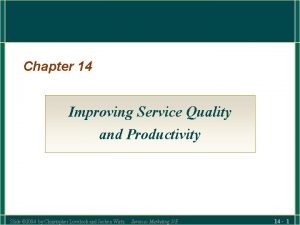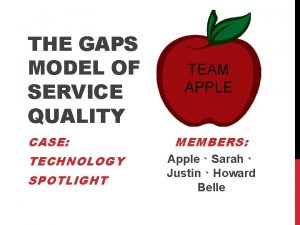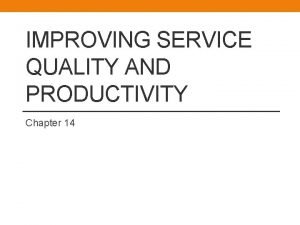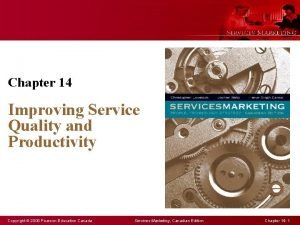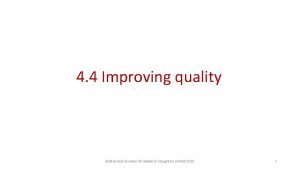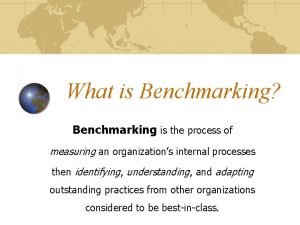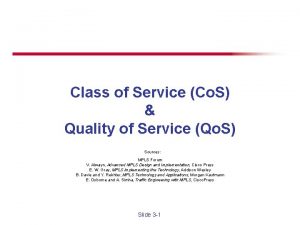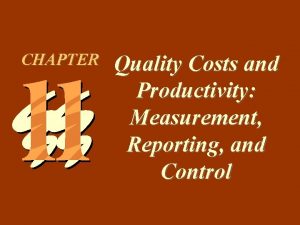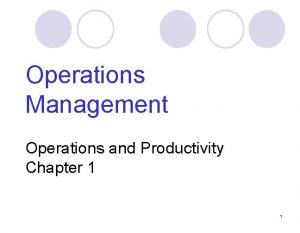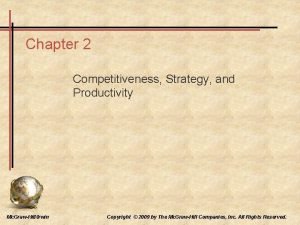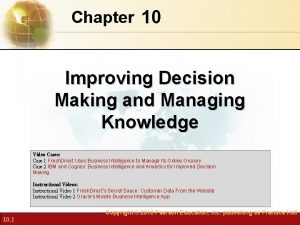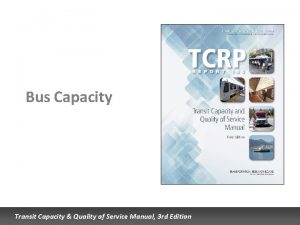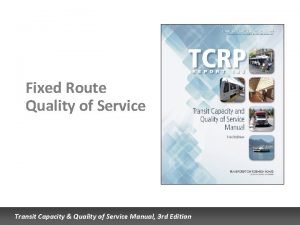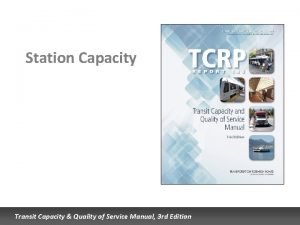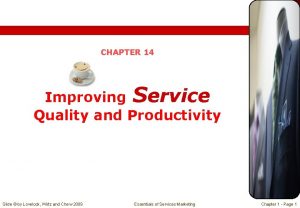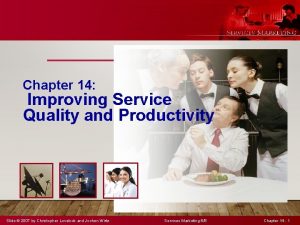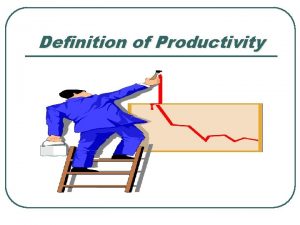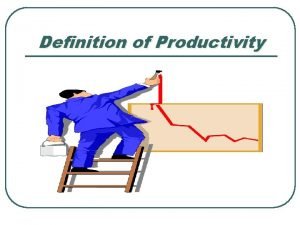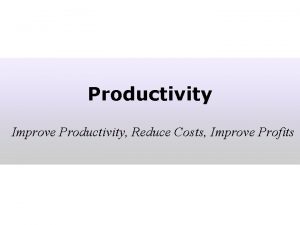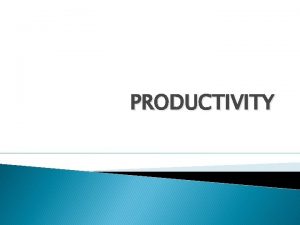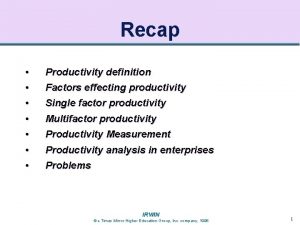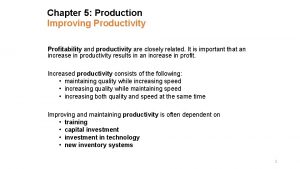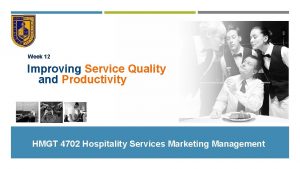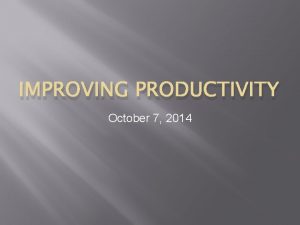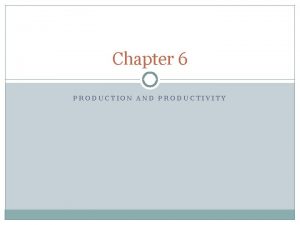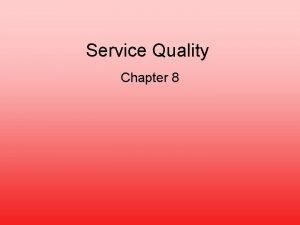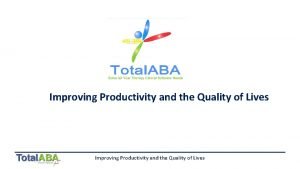Chapter 14 Improving Service Quality and Productivity 1













![SERVQUAL Questionnaire USA General Sample [1990] Dimension Weight Perceptions Expectations ──────────────────────────── Tangibles 0. 11 SERVQUAL Questionnaire USA General Sample [1990] Dimension Weight Perceptions Expectations ──────────────────────────── Tangibles 0. 11](https://slidetodoc.com/presentation_image_h2/9ab6c45e7d04e494b35c8c9b5dd3c0ea/image-14.jpg)
















- Slides: 30

Chapter 14: Improving Service Quality and Productivity 1

Integrating Service Quality and Productivity Strategies � Quality and productivity are twin paths to creating value for both customers and companies. � Quality focuses on the benefits created for customers. � productivity addresses financial costs incurred by firms. 2

What Is Service Quality? 3

Different Perspectives of Service Quality Transcendent: Quality = Excellence. Recognized only through experience Product-based: Quality is precise and measurable User-based: Quality lies in the eyes of the beholder Manufacturing- Quality is in conformance to the firm’s developed based: specifications Value-based: Quality is a trade-off between price and value 4

Components of Quality: Manufacturing-based Performance: Primary operating characteristics Features: Bells and whistles Reliability: Probability of malfunction or failure Conformance: Ability to meet specifications Durability: How long product continues to provide value to customer Serviceability: Speed, courtesy, competence Esthetics: How product appeals to users Perceived Quality: Associations such as brand name 5

Measuring and Improving Service Quality 6

SERVQUAL The Parasuraman, Zeithaml and Berry model. . � Originally identified 10 dimensions of quality and developed a list of 97 items on a seven point scale � After testing and subsequent refinement (i. e. factor analysis) the list was collapsed into a 22 item questionnaire covering 5 dimensions) called SERVQUAL

SERVQUAL 1. Tangibles 2. Reliability 3. Responsiveness 4. Assurance 5. Empathy These factors would differ in importance from service to service e. g. reliability is more important in a bank, empathy in a hospital!

Components of Quality: Service-based � � � Tangibles ◦ Appearance of physical facilities, equipment, personnel and communication materials. Reliability ◦ Ability to perform the promised service dependably and accurately. Responsiveness ◦ Willingness to help customers and provide prompt service. Assurance ◦ Knowledge and courtesy of employees and their ability to convey trust and confidence. Empathy ◦ The firm provides care and individualized attention to its customers. 9

Service Quality (SERVQUAL) Questionnaire Items RELIABILITY n n n Providing service as promised Dependability in handling customers’ service problems Performing services right the first time Providing services at the promised time Maintaining error-free records EMPATHY n n n RESPONSIVENESS n n Keeping customers informed as to when services will be performed Prompt service to customers Willingness to help customers Readiness to respond to customers’ requests ASSURANCE n n Employees who instill confidence in customers Making customers feel safe in their transactions Employees who are consistently courteous Employees who have the knowledge to answer customer questions Giving customers individual attention Employees who deal with customers in a caring fashion Having the customer’s best interest at heart Employees who understand the needs of their customers Convenient business hours TANGIBLES n n Modern equipment Visually appealing facilities Employees who have a neat, professional appearance Visually appealing materials associated with the service 10

Capturing the Customer’s Perspective of Service Quality: SERVQUAL (1) � Survey research instrument based on premise that customers evaluate firm’s service quality by comparing ◦ Their perceptions of service actually received ◦ Their prior expectations of companies in a particular industry � Poor quality ◦ Perceived performance ratings < expectations � Good quality ◦ Perceived performance ratings > expectations � Developed primarily in context of face-to-face encounters � Scale contains 22 items reflecting five dimensions of service quality � Subsequent research has highlighted some limitations of SERVQUAL 11

SERVQUAL Gap analysis The questionnaire is divided into 2 main sections: � Expectations measures what is anticipated in an ideal service (on a 7 -point scale) � Perceptions then measures those aspects of the service as actually delivered or experienced � Satisfaction (S) is conceptualized as the gap between expectations and perceptions � S=E-P

SERVQUAL 13
![SERVQUAL Questionnaire USA General Sample 1990 Dimension Weight Perceptions Expectations Tangibles 0 11 SERVQUAL Questionnaire USA General Sample [1990] Dimension Weight Perceptions Expectations ──────────────────────────── Tangibles 0. 11](https://slidetodoc.com/presentation_image_h2/9ab6c45e7d04e494b35c8c9b5dd3c0ea/image-14.jpg)
SERVQUAL Questionnaire USA General Sample [1990] Dimension Weight Perceptions Expectations ──────────────────────────── Tangibles 0. 11 5. 54 5. 16 Reliability 0. 32 5. 16 6. 44 Responsiveness 0. 22 5. 20 6. 36 Assurance 0. 19 5. 50 6. 50 Empathy 0. 16 5. 16 6. 28 ──────────────────────────── Weighted averages [n=1936] 5. 28 6. 27 (Source: calculated from Zeithaml, Parasuraman and Berry [1990] ) Gap +0. 38 -1. 28 -1. 16 -1. 00 -1. 12 -0. 99

SERVQUAL Questionnaire UK Hospital Outpatient Survey Dimension Weight Perceptions Expectations Gap ────────────────────────────────── Tangibles 0. 13 5. 21 5. 24 -0. 03 Reliability 0. 26 5. 52 6. 31 -0. 79 Responsiveness 0. 21 5. 88 6. 17 -0. 29 Assurance 0. 20 5. 98 6. 39 -0. 41 Empathy 0. 20 5. 66 6. 16 -0. 50 ────────────────────────────────── Weighted averages [n= 72] 5. 67 6. 15 -0. 48

SERVQUAL Questionnaire Finland Hospital Outpatient Survey Dimension Weight Perceptions Expectations Gap ────────────────────────────────── Tangibles 0. 18 5. 64 6. 03 -0. 38 Reliability 0. 21 5. 51 6. 04 -0. 54 Responsiveness 0. 20 5. 73 6. 12 -0. 39 Assurance 0. 22 5. 83 6. 23 -0. 40 Empathy 0. 19 5. 74 6. 08 -0. 35 ────────────────────────────────── Weighted averages [n= 135] 5. 72 6. 14 -0. 41

Service Quality Perceptions Relative to Zones of Tolerance 9 8 7 6 O O O 5 4 3 2 1 0 Reliability Insurance Agency Responsiveness Assurance Empathy Tangibles = Zone of Tolerance O = Service Quality Perception 17

Soft and Hard Measures of Service Quality � Hard measures— refer to standards and measures that can be counted, timed or measured through audits ◦ Typically operational processes or outcomes ◦ Standards often set with reference to percentage of occasions on which a particular measure is achieved ◦ Control charts are useful for displaying performance over time against specific quality standards � e. g. how many trains arrived late? � Soft measures— refer to standards and measures that cannot easily be observed and must be collected by talking to customers, employees or others ◦ Provide direction, guidance, and feedback to employees on ways to achieve customer satisfaction ◦ Can be quantified by measuring customer perceptions and beliefs � e. g. SERVQUAL, surveys, and customer advisory panels 18

Portfolio of Services Research Objective Type of Research Identify dissatisfied customers to attempt recovery; identify most common categories of service failure for remedial action Customer Complaint Solicitation Assess company’s service performance compared to competitors; identify service-improvement priorities; track service improvement over time “Relationship” and SERVQUAL Surveys Obtain customer feedback while service experience is fresh; act on feedback quickly if negative patterns develop Use as input for quantitative surveys; provide a forum for customers to suggest service-improvement ideas Measure individual employee service behaviors for use in coaching, training, performance evaluation, recognition and rewards; identify systemic strengths and weaknesses in service Post-Transaction Surveys Customer Focus Groups “Mystery Shopping” of Service Providers Measure internal service quality; identify employeeperceived obstacles to improve service; track employee morale and attitudes Employee Surveys Determine the reasons why customers defect Lost Customer Research Forecast future expectations of customers; develop and test new service ideas Future Expectations Research 19

Soft Measures of Service Quality � Key customer-centric SQ measures include: ◦ ◦ Total market surveys, annual surveys, transactional surveys Service feedback cards Mystery shopping Analysis of unsolicited feedback—complaints and compliments, focus group discussions, and service reviews Ongoing surveys of account holders to determine satisfaction in terms of broader relationship issues � Customer advisory panels offer feedback/advice on performance � Employee surveys and panels to determine: � ◦ Perceptions of the quality of service delivered to customers on specific dimensions ◦ Barriers to better service ◦ Suggestions for improvement 20

Hard Measures of Service Quality � Control charts to monitor a single variable ◦ Offer a simple method of displaying performance over time against specific quality standards ◦ Are only good if data on which they are based is accurate ◦ Enable easy identification of trends � Service quality indexes ◦ Embrace key activities that have an impact on customers 21

Composition of Fed. Ex’s Service Quality Index—SQI Failure Type Weighting Number of Daily X = Factor Incidents Points Late delivery—right day Late Delivery—wrong day Tracing request unanswered Complaints reopened Missing proofs of delivery Invoice adjustments Missed pickups Lost packages Damaged packages Aircraft delays (minutes) Overcharged (packages missing label) Abandoned calls 1 5 1 1 10 10 10 5 5 1 Total Failure Points (SQI) = XXX, XXX 22

Control Chart for Departure Delays % Flights Departing Within 15 Minutes of Schedule 100% 90% 80% 70% 60% J F M A M J J A S O N D Month 23

Tools to Analyze and Address Service Quality Problems � Fishbone diagram ◦ Cause-and-effect diagram to identify potential causes of problems � Pareto Chart ◦ Separating the trivial from the important. Often, a majority of problems is caused by a minority of causes (i. e. the 80/20 rule) � Blueprinting ◦ Visualization of service delivery, identifying points where failures are most likely to occur 24

Fishbone Diagram Template 25

Cause-and-Effect Chart 26

Cause-and-Effect Chart for Flight Departure Delays Facilities, Equipment Arrive late Oversized bags Customers Frontstage Front-Stage Personnel Procedures Delayed check-in Gate agents Aircraft late to procedure gate cannot process fast enough Mechanical Acceptance of late Failures passengers Late/unavailable Late pushback airline crew Delayed Departures Late food service Other Causes Weather Air traffic Late baggage Poor announcement of departures Weight and balance sheet late Late fuel Materials, Supplies Late cabin cleaners Backstage Personnel Information 27

Case: Analysis of Causes of Flight Departure Delays 15. 3% 23. 1% 15. 4% All stations, excluding Chicago-Midway Hub 11. 7% 23. 1% Newark 15% Late passengers Waiting for pushback Waiting for fuelling 19% 33. 3% 9. 5% 8. 7% 11. 3% 4. 9 % 33. 3% 53. 3% Washington Natl. Late weight and balance sheet Late cabin cleaning/supplies Other 28

Return On Quality (ROQ) � Assess costs and benefits of quality initiatives ◦ ROQ approach is based on four assumptions: – Quality is an investment – Quality efforts must be financially accountable – It’s possible to spend too much on quality – Not all quality expenditures are equally valid ◦ Implication: Quality improvement efforts may benefit from being related to productivity improvement programs ◦ To determine feasibility of new quality improvement efforts, determine costs and then relate to anticipated customer response � Determine optimal level of reliability ◦ Diminishing returns set in as improvements require higher investments ◦ Know when improving service reliability becomes uneconomical 29

When Does Improving Service Reliability Become Uneconomical? Satisfy Target Customers through Service Recovery Service Reliability 100% Optimal Point of Reliability: Cost of Failure = Service Recovery A B C Small Cost, Large Improvement D Large Cost, Small Improvement Satisfy Target Customers through Service Delivery as Planned Investment Assumption: Customers are equally (or even more) satisfied with the service recovery provided than with a service that is delivered as planned. 30
 Service quality and productivity
Service quality and productivity Listening gap examples
Listening gap examples Gaps model for improving service quality
Gaps model for improving service quality Service quality and productivity
Service quality and productivity Starbucks inputs and outputs
Starbucks inputs and outputs Difficulties of improving quality business
Difficulties of improving quality business Relationship between safety, quality and productivity
Relationship between safety, quality and productivity What is benchmarketing
What is benchmarketing Improving hr service delivery
Improving hr service delivery Class of service vs quality of service
Class of service vs quality of service Cost of quality examples
Cost of quality examples Condone noun form
Condone noun form Chapter 12 lesson 4 fitness safety and avoiding injuries
Chapter 12 lesson 4 fitness safety and avoiding injuries Improving vocabulary skills chapter 9
Improving vocabulary skills chapter 9 Chapter 3 benefits of physical activity
Chapter 3 benefits of physical activity Operation and productivity chapter 1
Operation and productivity chapter 1 Unitless measure of productivity
Unitless measure of productivity Strategy and productivity
Strategy and productivity Quality assurance vs quality control
Quality assurance vs quality control Quality control basics
Quality control basics Improving own learning and performance examples
Improving own learning and performance examples Improving vocabulary with word parts and context clues
Improving vocabulary with word parts and context clues Improving vocabulary with word parts and context clues
Improving vocabulary with word parts and context clues Improving decision making and managing knowledge
Improving decision making and managing knowledge Transit capacity and quality of service manual
Transit capacity and quality of service manual Transit capacity and quality of service manual
Transit capacity and quality of service manual Transit capacity and quality of service manual
Transit capacity and quality of service manual Pmp quality management
Pmp quality management Quality metrics pmp
Quality metrics pmp Define quality assurance in nursing
Define quality assurance in nursing Compliance vs quality
Compliance vs quality
